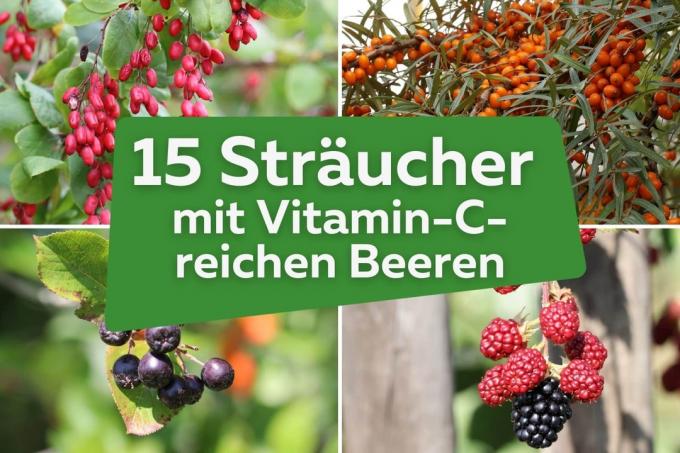
Fruit bushes are often suitable for small gardens or even for the balcony or terrace in a bucket. If you value a good supply of vitamins, you can use shrubs that produce many berries rich in vitamin C.
In a nutshell
- there are many native fruit bushes rich in vitamin C
- including wild species
- cultivated fruit often brings higher yields
- after harvesting, the berries should be processed quickly
- Otherwise, the vitamin C content will drop quickly
Table of contents
- Shrubs with berries rich in vitamin C from A – B
- G – H
- K-R
- Berry bushes with S
- frequently asked Questions
Shrubs with berries rich in vitamin C from A – B
chokeberry (Aronia melanocarpa)
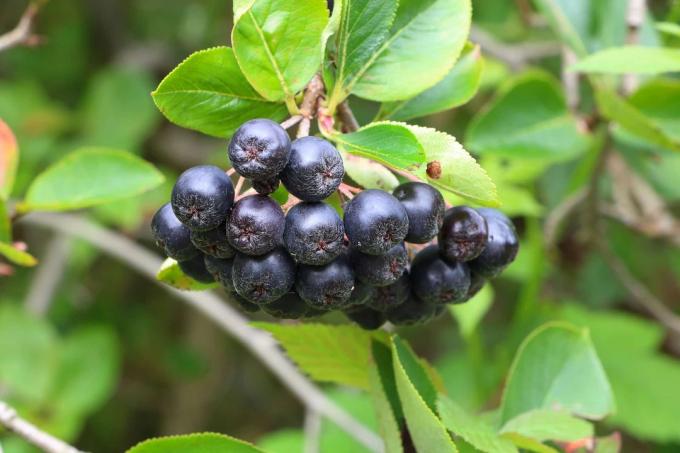
The berries of the Aronia taste not only humans, but also birds. If not harvested, they can remain hanging into winter and serve as bird seed.
- characteristics: up to 2 m in height and 1 m in width, forms runners, red autumn colours
- Origin: North America
- Care: sunny, nutrient-rich location, cut back every 2 years
- bloom and harvest: blooms in May, berries ripen in summer
- preservation: Process into juice or jam
- propagation: forms runners, self-seeding
barberries (Berberis), sour thorn

The common sour thorn (Berberis vulgaris) grows wild here. For the garden there are some breeds with different flower colors and growth forms.
- characteristics: dense shrub, medium-tall, arching habit, some varieties are evergreen, others are reddish in autumn, all with thorns
- Happen: partly native, Asia
- Care: sunny location, well-drained soil, mulch young plants and water occasionally, easy to care for later, tolerates pruning
- bloom and harvest: yellow flowers in May, red berries remain until winter
- preservation: Process berries into juice or jelly
- propagation: about cuttings
A notice: There are a few slightly poisonous barberry species. When choosing, make sure you choose an edible variety.
blackberry (Rubus fruticosus)
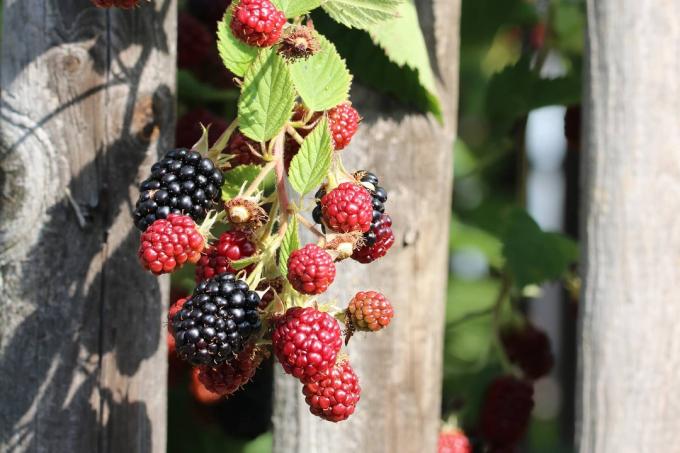
Next to the wild blackberriesthat have thorns, there are thornless varieties for the garden that make harvesting much easier.
- characteristics: forms rods up to 2 m long, leaves sometimes remain hanging until winter
- Happen: native
- Care: mulching, fertilizing in spring, watering when dry, pruning out old shoots every year and tying them to the trellis
- bloom and harvest: flowers white or pink in spring, first berries appear from July to autumn
- preservation: drying, freezing, suitable for jam
- propagation: spreads strongly by itself without countermeasures by stolons
G – H
goji berry (Lycium barbaru or L. chinense), common or Chinese wolfberry

The goji berry is called a superfood because of its ingredients. The vitamin C-rich berries can be dried well.
- characteristics: up to 3 m tall, grows quickly and sprawling, overhanging
- Happen: native or from Asia
- Care: sunny location, well-drained soil, water young plants, fertilize in spring, cut back now and then
- bloom and harvest: purple flowers from June, orange to red berries ripen from summer
- preservation: dry or process into juice and jelly
- propagation: by stolons
blueberry (vaccinium), blueberry
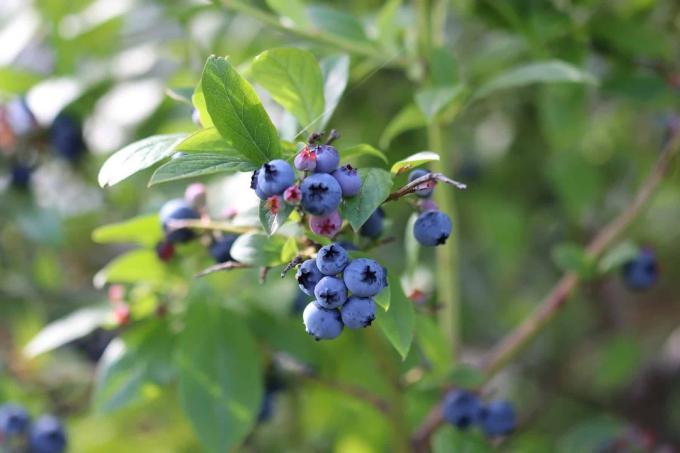
Of importance are mainly the wild native blueberries or those suitable for the garden cultivated blueberry from North America. Both bear many vitamin C-rich berries in late summer.
- characteristics: wild bilberry, small, ground-covering shrub, cultivated bilberry up to 1.50 m tall, red autumn colour
- Happen: native or North America
- Care: partially shaded to sunny location, well-drained, nutrient-rich, slightly acidic soil, mulch with bark mulch, keep moist, in spring cut back
- bloom and harvest: white flowers from May, ripe berries from July until autumn
- preservation: process into juice, boil down or freeze
- propagation: by stolons
raspberry (Rubus idaeus)
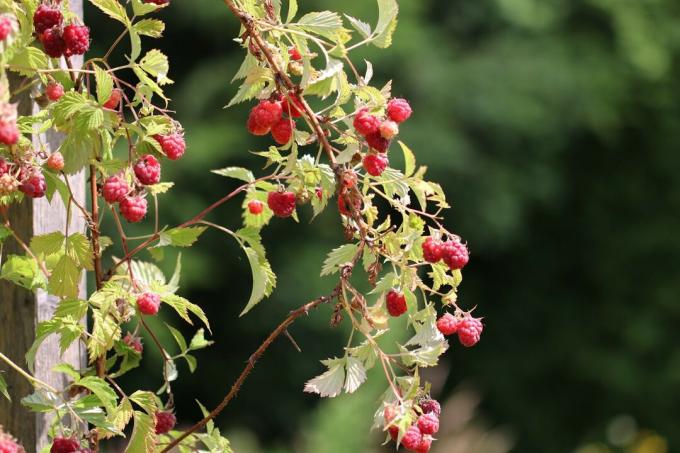
There are raspberries that bear fruit that ripen in summer and varieties that ripen well into autumn. Raspberries also grow wild on field edges or in hedges.
- characteristics: Tails are up to 1.50 m long, grow upright, hardly branched
- Happen: native
- Care: sunny location, more permeable, nutrient-rich soil, keep moist, mulch, fertilize in spring, in the autumn cut back
- bloom and harvest: white flowers in spring, yellow or red berries from summer
- preservation: drying, freezing, processing into jam, boiling down
- propagation: by stolons
elder (Sambucus)

In addition to the black elder there is also the red elder. For both types, the berries should not be eaten raw.
- characteristics: wild shrub several meters high, multi-stemmed, pinnate leaves, typical smell
- Happen: native
- Care: sunny to semi-shady location, well-drained, nutrient-rich soil, hardly any further care necessary, cut compatible
- blossom and harvest: forms umbrella panicles, flowers from April, berries ripen in summer
- preservation: process into juice or jelly, Freeze berries, also Flowers can be used as a tea be used
- propagation: stolon, self-seeding
K-R
cornel (Cornusmas)
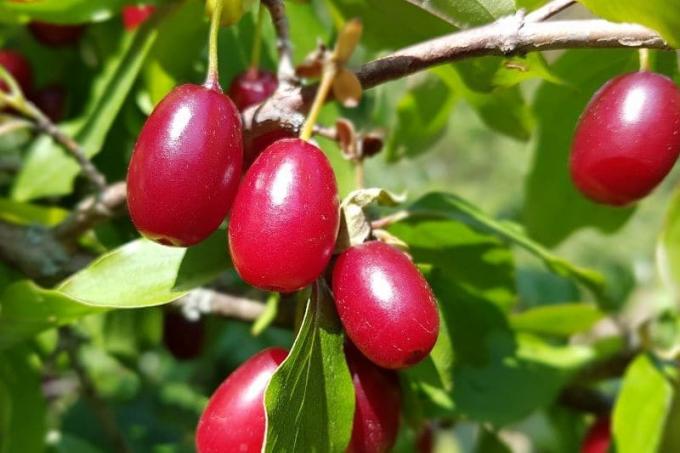
The cornel is a very large shrub that botanically does not belong to the cherries, but to the dogwood family. If it is grown as a single trunk, it can also be used as a tree.
- characteristics: up to 8 m high, slow-growing, richly branched crown
- Happen: native
- Care: sunny location, nutrient-rich soil, enough space, easy to care for, tolerates pruning
- bloom and harvest: yellow flowers from the end of February, cornelian cherries ripen from August
- preservation: freeze, boil down, juice or jelly
- propagation: about sowing
A notice: The cornel is a valuable bird and insect protection tree.
cranberry (Vaccinium vitis-idaea)

Like the blueberry, the cranberry belongs to the heather family. The berries of the shrub, which are rich in vitamin C, have been collected and used for centuries.
- characteristics: up to 40 cm high, grows with many branches, evergreen
- Happen: native, but also cultivars from North America
- Care: sunny to semi-shady location, acidic, moist and nutrient-rich soil, keep moist, otherwise easy to care for
- bloom and harvest: blooms twice, May-June and July-August, most fruits ripen after the second bloom
- preservation: very acidic when raw, so boil, dry, process into juice or jam
- propagation: by stolons
Red currant (Ribes rubrum)
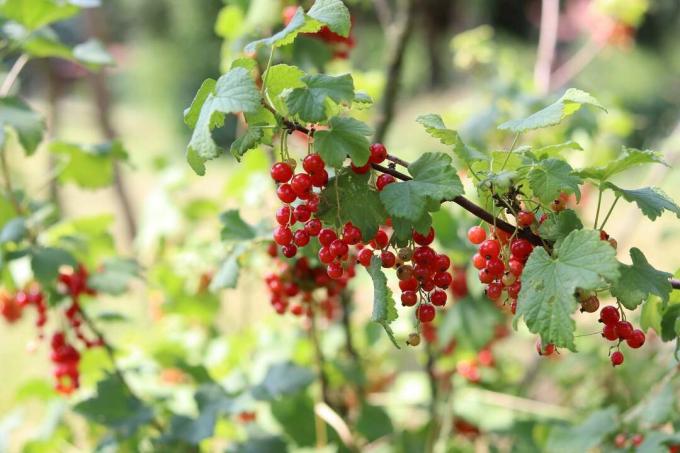
The red currant is represented in many gardens because it is a popular summer fruit. The berries of the shrub contain many healthy nutrients, including vitamin C.
- characteristics: upright shrub with several shoots, up to 1.50 m tall
- Happen: native
- Care: sunny location, nutrient-rich, permeable soil, water when dry, mulch, fertilize in spring, after harvest cut back old shoots
- bloom and harvest: inconspicuous panicles of flowers from April, berries ripen from June
- preservation: freeze, boil down, process into juice or jelly
- propagation: by cuttings or runners, rarely also seeds
Berry bushes with S
sea buckthorn (Hippophae rhamnoides)
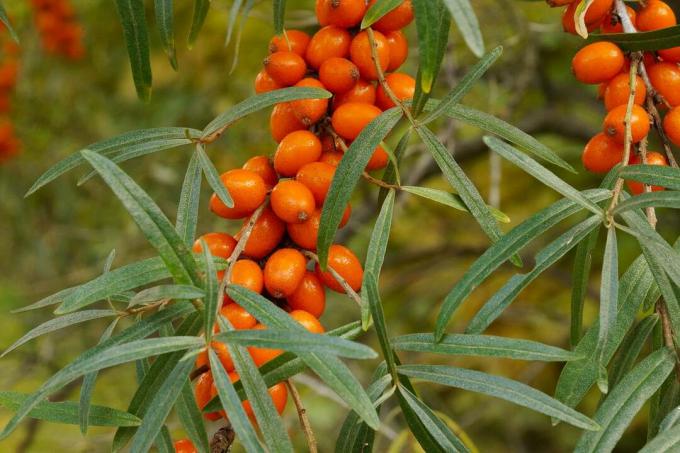
The sea buckthorn only reliably bears vitamin C-rich berries if several female shrubs are planted together with a male shrub. Only then will the flowers be sufficiently fertilized.
- characteristics: spreading, irregular, light crown, up to 5 m high, shoots have thorns
- Happen: native
- Care: sunny location, sandy, well-drained soil, fertilize from time to time, it makes sense to cut back older shrubs
- bloom and harvest: blooms from March, Fruit ripening from August
- preservation: freeze, boil down, process into juice or jam
- propagation: by stolons
sloe (Prunus spinosa)

sloes are actually not berries, but their fruits are very small, remind of berries and contain a lot of vitamin C. They are really edible only after exposure to frost.
- characteristics: up to 5 m high, sprawling growth, has thorns, autumn colour
- Happen: native
- Care: sunny to semi-shady location, nutrient-rich soil, needs no care
- bloom and harvest: white flowers from March, harvest best after the first frost
- preservation: process into juice, syrup and jelly
- propagation: through runners, very keen on spreading, root barrier useful
Blackcurrant (Ribes nigrum)

Blackcurrants taste very different from red or white currants. However, the fruits can be processed and used just as well.
- characteristics: up to 2 m tall, upright, hardly branched shoots
- Happen: native
- Care: sunny location, well-drained, nutrient-rich soil that is not too dry, mulch, keep moist, fertilize in spring, cut back after harvest
- bloom and harvest: Flower spikes appear in early spring, the vitamin C-rich berries ripen from June
- preservation: freeze, process into juice, syrup, jelly or jam
- propagation: by cuttings
frequently asked Questions
It is allowed to collect small amounts of wild fruit. It is not allowed to damage bushes in order to be able to pick the berries. Commercial collecting is also prohibited. In any case, ownership should be clarified beforehand.
Only edible berry species are included in this list. At most, eating the raw berries can make some species feel unwell. However, there are also poisonous berries that one should be able to distinguish precisely from the edible ones before collecting berries in nature.
It is best if the vitamin C-rich berries are eaten as fresh and unprocessed as possible. However, this is not possible with some types of berries because they do not taste good raw or should not be eaten. The longer and the higher the berries are heated, the more vitamin C they lose.

